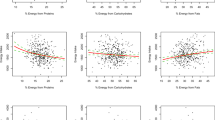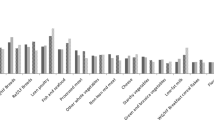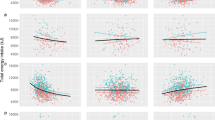Abstract
Background
A high-protein diet in infancy increases the risk of obesity, but the effects of dietary protein intake in mid-childhood on body composition are unclear. Therefore, we studied associations of protein intake (total, animal and plant-sourced) at 8 years of age with anthropometric measures and body composition up to age 10 years.
Methods
We included 3991 children of the Generation R Study, a prospective cohort in the Netherlands. Dietary protein intake was assessed at 8 years of age using a food-frequency questionnaire and is expressed in energy percentage (E%). Anthropometric measures and body composition (using dual-energy X-ray absorptiometry (DXA)) were assessed at 6 years and during follow-up at 10 years. We calculated body mass index (BMI), fat mass index (FMI), and fat-free mass index (FFMI). All outcomes were sex- and age-standardized and overweight (yes/no) was derived from BMI-SDS. We examined associations of protein intake at 8 years with the combined risk of overweight and obesity, and body composition at 10 years using multivariable logistic and linear regression models. These analyses were adjusted for outcomes at 6 years and protein intake in early life.
Results
In multivariable-adjusted models, a 5E% higher protein intake at 8 years was associated with a higher combined risk of overweight and obesity up to 10 years (odds ratio (OR) 1.51, 95% confidence interval (CI): 1.22,1.86), independent of whether it replaced carbohydrates or fat. However, this was mainly explained by an association of protein intake with a higher FFMI (0.07 standard deviation scores (SDS) per 5E%, 95% CI: 0.02,0.11), not FMI. Both plant and animal were associated with a higher FFMI, but the association was stronger for protein from plant sources. For FMI, our findings also suggest trends of higher plant protein intake with lower FMI, and higher animal protein intake with higher FMI. Following this, a higher plant protein intake at the expense of animal protein was associated with a lower FMI (−0.08 SDS per 5E%, 95% CI: −0.15,−0.01).
Conclusions
We observed that a higher protein intake in mid-childhood is associated with a higher fat-free mass. Our findings also suggest that protein from plant sources seems to be beneficial for body composition in school-age children.
This is a preview of subscription content, access via your institution
Access options
Subscribe to this journal
Receive 12 print issues and online access
$259.00 per year
only $21.58 per issue
Buy this article
- Purchase on Springer Link
- Instant access to full article PDF
Prices may be subject to local taxes which are calculated during checkout

Similar content being viewed by others
References
Dewey KG, Beaton G, Fjeld C, Lonnerdal B, Reeds P. Protein requirements of infants and children. Eur J Clin Nutr. 1996;50(Suppl 1):S119–47. discussionS147-50
Eloranta AM, Lindi V, Schwab U, Tompuri T, Kiiskinen S, Lakka HM, et al. Dietary factors associated with overweight and body adiposity in Finnish children aged 6-8 years: the PANIC Study. Int J Obes. 2012;36:950–5.
Gunther AL, Remer T, Kroke A, Buyken AE. Early protein intake and later obesity risk: which protein sources at which time points throughout infancy and childhood are important for body mass index and body fat percentage at 7 y of age? Am J Clin Nutr. 2007;86:1765–72.
Weber M, Grote V, Closa-Monasterolo R, Escribano J, Langhendries JP, Dain E, et al. Lower protein content in infant formula reduces BMI and obesity risk at school age: follow-up of a randomized trial. Am J Clin Nutr. 2014;99:1041–51.
Voortman T, Braun KV, Kiefte-de Jong JC, Jaddoe VW, Franco OH, van den Hooven EH. Protein intake in early childhood and body composition at the age of 6 years: The Generation R Study. Int J Obes. 2016;40:1018–25.
Koletzko B, Broekaert I, Demmelmair H, Franke J, Hannibal I, Oberle D et al. Protein intake in the first year of life: a risk factor for later obesity? The E.U. childhood obesity project. Adv Exp Med Biol. 2005;569:69-79.
Ong K, Kratzsch J, Kiess W, Dunger D. Circulating IGF-I levels in childhood are related to both current body composition and early postnatal growth rate. J Clin Endocrinol Metab. 2002;87:1041–4.
Assmann KE, Joslowski G, Buyken AE, Cheng G, Remer T, Kroke A, et al. Prospective association of protein intake during puberty with body composition in young adulthood. Obesity. 2013;21:E782–9.
Dunger DB, Salgin B, Ong K. Muscle mass and insulin sensitivity in children and adolescents. Horm Res Paediatr. 2006;66(Suppl. 1):79–84.
Kooijman MN, Kruithof CJ, van Duijn CM, Duijts L, Franco OH, van IJzendoorn MH, et al. The Generation R Study: design and cohort update 2017. Eur J Epidemiol. 2016;31:1243–64.
Dutman AE, Stafleu A, Kruizinga A, Brants HA, Westerterp KR, Kistemaker C, et al. Validation of an FFQ and options for data processing using the doubly labelled water method in children. Public Health Nutr. 2011;14:410–7.
van der Velde LA, Nguyen AN, Schoufour JD, Geelen A, Jaddoe VWV, Franco OH, et al. Diet quality in childhood: the Generation R Study. Eur J Nutr. 2018. PMID: 29516225, https://doi.org/10.1007/s00394-018-1651-z Print ISSN: 1436-6207.
Dutch Food Composition Table (Nederlands voedingsstoffenbestand, NEVO) 2001. Voedingscentrum: The Hague, the Netherlands, 2001.
Willett WC, Howe GR, Kushi LH. Adjustment for total energy intake in epidemiologic studies. Am J Clin Nutr. 1997;65(4 Suppl):1220S–8S. discussion 1229S-1231S
Cole TJ, Bellizzi MC, Flegal KM, Dietz WH. Establishing a standard definition for child overweight and obesity worldwide: international survey. Br Med J. 2000;320:1240–3.
Niklasson A, Ericson A, Fryer JG, Karlberg J, Lawrence C, Karlberg P, et al. An update of the Swedish reference standards for weight, length and head circumference at birth for given gestational age (1977-1981). Acta Paediatr Scand. 1991;80:756–62.
Voortman T, Kiefte-de Jong JC, Geelen A, Villamor E, Moll HA, de Jongste JC, et al. The development of a diet quality score for preschool children and its validation and determinants in the Generation R Study. J Nutr. 2015;145:306–14.
Durrleman S, Simon R. Flexible regression models with cubic splines. Stat Med. 1989;8:551–61.
Sterne JA, White IR, Carlin JB, Spratt M, Royston P, Kenward MG, et al. Multiple imputation for missing data in epidemiological and clinical research: potential and pitfalls. Br Med J. 2009;338:b2393.
Health Council of the Netherlands. Dietary reference intakes: energy, proteins, fats, and digestible carbohydrates. The Hague: Health Council of the Netherlands, 2001; publication no. 2001/19R, page 80.
van Vught AJAH, Heitmann BL, Nieuwenhuizen AG, Veldhorst MAB, Brummer R-JM, Westerterp-Plantenga MS, et al. Association between dietary protein and change in body composition among children (EYHS). Clin Nutr. 2009;28:684–8.
Maffeis C, Talamini G, Tato L. Influence of diet, physical activity and parents’ obesity on children’s adiposity: a four-year longitudinal study. Int J Obes Relat Metab Disord. 1998;22:758–64.
Central Bureau for Statistics. Children with overweight and obesity in the Netherlands (2016). https://www.volksgezondheidenzorg.info/onderwerp/overgewicht/cijfers-context/huidige-situatie#node-overgewicht-kinderen.
Wright M, Sotres-Alvarez D, Mendez MA, Adair L. The association of trajectories of protein intake and age-specific protein intakes from 2 to 22 years with BMI in early adulthood. Br J Nutr. 2017;117:750–8.
Jeffery AN, Metcalf BS, Hosking J, Streeter AJ, Voss LD, Wilkin TJ. Age before stage: insulin resistance rises before the onset of puberty. Diabetes Care. 2012;35:536–41.
Siervogel RM, Maynard LM, Wisemandle WA, Roche AF, Guo SS, Chumlea WC, et al. Annual changes in total body fat and fat‐free mass in children from 8 to 18 years in relation to changes in body mass index: the Fels Longitudinal Study. Ann N Y Acad Sci. 2000;904:420–3.
Westerterp-Plantenga M, Luscombe-Marsh N, Lejeune M, Diepvens K, Nieuwenhuizen A, Engelen M, et al. Dietary protein, metabolism, and body-weight regulation: dose–response effects. Int J Obes. 2006;30:S16–S23.
Chalvon-Demersay T, Azzout-Marniche D, Arfsten J, Egli L, Gaudichon C, Karagounis LG, et al. A systematic review of the effects of plant compared with animal protein sources on features of metabolic syndrome. J Nutr. 2017;147:281–92.
Luo J, Yang M, Xue H, Pan J, Libuda L, Muckelbauer R, et al. High protein intake along with paternal part-time employment is associated with higher body fat mass among girls from South China. FASEB J. 2017;31(1 Supplement):649.2–649.2. https://doi.org/10.1007/s00394-017-1468-1.
World Health Organization. Protein and amino acid requirements in human nutrition. In: World health organization technical report series; 2007. World Health Organization, Geneva.
Wells JC. A Hattori chart analysis of body mass index in infants and children. Int J Obes Relat Metab Disord. 2000;24:325–9.
Kipnis V, Subar AF, Midthune D, Freedman LS, Ballard-Barbash R, Troiano RP, et al. Structure of dietary measurement error: results of the OPEN biomarker study. Am J Epidemiol. 2003;158:14–21. discussion 22-6.
Acknowledgements
The Generation R Study is conducted by the Erasmus Medical Center in close collaboration with the School of Law and the Faculty of Social Sciences at the Erasmus University, Rotterdam; the Municipal Health Service, Rotterdam area; and the Stichting Trombosedienst and Artsenlaboratorium Rijnmond (Star-MDC), Rotterdam. We gratefully acknowledge the contribution of participating mothers, general practitioners, hospitals, midwives, and pharmacies in Rotterdam, the Netherlands. This work was supported by the Erasmus Medical Center, Rotterdam; the Erasmus University, Rotterdam; the Dutch Ministry of Health, Welfare and Sport; and the Netherlands Organization for Health Research and Development (ZonMw). V.W.V.J. was supported by a grant from the Netherlands Organization for Health Research and Development (VIDI 016.136.361), a European Research Council Consolidator Grant (ERC-2014-CoG-648916), and funding from the European Union’s Horizon 2020 research and innovation program under grant agreements no. 733206 (LifeCycle) and no. 633595 (DynaHEALTH). T.V. received additional support from the Thrasher Research Fund. L.G.K. works at the Nestlé Research Center. V.J., O.H.F., and T.V. work in ErasmusAGE, a center for aging research across the life course. The current work was financially supported by Nestlé Research Center (Nestec).
Author contributions
The authors’ responsibilities were as follows: V.J., L.G.K., and T.V. designed the research project; V.W.V.J. and O.H.F. were involved in the study design and data collection; V.J. and T.V. analyzed the data; L.G.K., V.W.V.J., and O.H.F. provided consultation regarding the analyses and interpretation of the results; V.J. and T.V. wrote the manuscript; V.J., L.G.K., and T.V. had primary responsibility for the final content. All authors read and approved the final manuscript.
Author information
Authors and Affiliations
Corresponding author
Ethics declarations
Conflict of interest
The authors declare that they have no conflict of interest.
Electronic supplementary material
Rights and permissions
About this article
Cite this article
Jen, V., Karagounis, L.G., Jaddoe, V.W.V. et al. Dietary protein intake in school-age children and detailed measures of body composition: the Generation R Study. Int J Obes 42, 1715–1723 (2018). https://doi.org/10.1038/s41366-018-0098-x
Received:
Revised:
Accepted:
Published:
Issue Date:
DOI: https://doi.org/10.1038/s41366-018-0098-x



